
|
|
 |

|


 What in the HD World? What in the HD World?CES 2009 Report
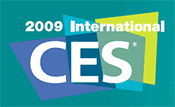 Dick De Jong
Dick De JongM.R. Dinkins January 14, 2009 HDTV Solutions Coming in the first week of January, the massive Consumer Electronics Show in Las Vegas ushers in the new year for gadgets big and small. In the past, CES greeted the world with a roar. In 2009, malnourished by a stagnant economy, this lion was leaner and more subdued. For example in the HDTV arena, all of the major players were exhibiting but the usual gush about new products seemed to be sobered by the prospects for lackluster consumer spending. 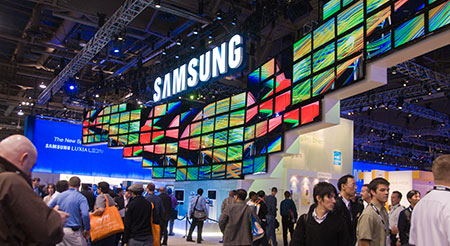 Samsung's Booth at CES 2009 Then again, the consumer electronics industry is never one to stand still. And exploring the exhibits dotting the miles of aisles of the CES showrooms provides a great overview of the trends for 2009 and beyond. 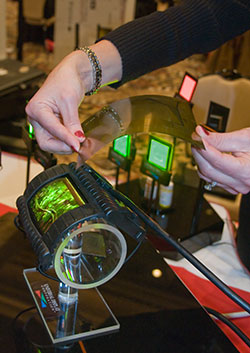 UDC OLED Bracelet OLEDs and LEDs
Let's start with the sexiest topic, OLEDs (Organic Light Emitting Diodes), which unlike LEDs do not need a backlight to display an image, therefore they can be thinner - even flexible. One company, Universal Display Corporation was showing a prototype of an OLED screen that you wrap around your wrist like a high tech bling bracelet. Actually, a UDC representative indicated that the military was interested in it as a display for soldiers in the field. On the HDTV front, Sony's 11" XEL-1 is still the only OLED TV that is available at this time and its price remains at $2499. And even though, Sony, LG and Samsung were showing prototypes of larger (up to 30") OLED screens, don't except to see a flood of models in 2009. 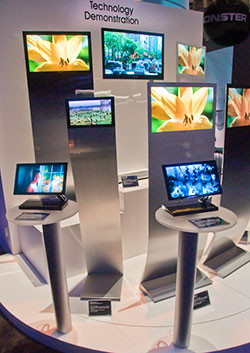 Sony's OLED Tech Demo The gorgeous picture quality of OLED displays is indisputable. It's the economics of production that is stalling the parade. Since smaller screens seem to be more cost effective to manufacture, the first OLED for most of us will be in our cellphones. I even talked to an industry insider who agreed that we may never see large (over 40") OLED TVs. By the time our global economy turns its frown upside down and manufacturers find a cheaper method of production, the window for OLEDs to capture a meaningful share of the HDTV market might have vanished. I'm sure that I could be wrong, but even savvy market analysts don't forecast OLEDs to have an impact until 2011 or 2012. Videophiles don't despair. The advancement of the garden variety LED technology marches on with stunning results. Traditionally, TVs with LCD panels have been backlit with Cold Cathode Fluorescent Lamps (CCFLs). In the last couple of years, more and more LCDs use LEDs for backlights. If the LEDs are located along the edge of the LCD, instead of behind it, then the TV can be thinner, with some edge lit models slimming to under a half an inch thick. What is more appealing to me is placing the LEDs behind the panel in an array of lights. Then LEDs in darker areas of the picture can be dimmed, which increases contrast. This year, panel manufacturers like LG Display are introducing new LCD screens with more LED backlight arrays, which will allow more accurate local dimming and even better picture quality. Of course with the LEDs behind the panel instead of along the edge, the TV can't be as skinny. Though LG's LED backlit LHX 55" LCD TV is less than one-inch thick at its thinnest. But if I have to choose, I'll take picture quality over a razor thin profile any day. While we are on the topic, the rush to crush HDTVs thinner than crepes continues. Everyone seems to be showing off their Twiggy-like TVs, some measured in millimeters at the narrowest part of the frame. Models such as Sharp's Limited Edition XS1U-S and Sony's KLV-40ZX1M loosen their belt buckles a bit at the base of the screen to accommodate power cords and audio video connections. I admire the technological prowess it takes to roll out a display this slender. But after the initial neck bending gawk to marvel at the wispy contour, I turn my attention to the quality of the image on the screen. Happily both the Sharp and Sony deliver the eye popping performance that you would expect from these flagship TVs. 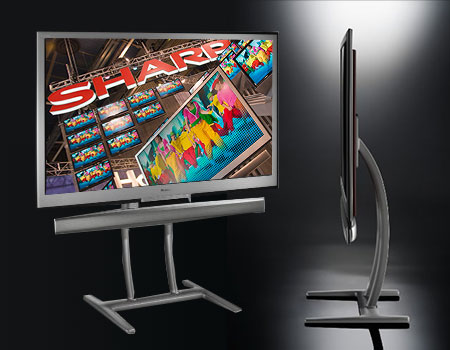 Sharp's XS1U-S Limited Edition LCD HDTV Hertz until it Hurts
Perhaps the term that is most indicative of what is good and bad about the current HDTV market is Hertz (Hz). To begin, who can remember what Hz stands for? (A unit of frequency equal to one cycle per second.) O.K. Then how does that apply to a 60Hz HDTV? (The TV displays 60 frames per second.) Then why not just say that? Last year, at CES 2008, LCD manufacturers began trumpeting this great technological breakthrough, 120Hz displays, that would smooth out fast action scenes and make them crisp, clean and judder free. Just when the buying public was absorbing the notion of 120 frames per second HDTVs, we now are presented with 240Hz models. (I will not burden you with the explanation of how some scanning backlight applications are not truly 240 new frames per second.) What I find problematic - beyond the fact of trying to understand this more and more arcane theory - is how the companies are presenting the new features. In 2008, exhibitors were offering side-by-side comparisons of 60Hz and 120Hz LCDs with text quickly scrolling across the screen. To distill their spiel, 60Hz: jittery crap; 120Hz: smooth as mother's milk. Jump to 2009 and now it's 120Hz side by 240Hz side. And the claims, 120Hz: smudgy crap; 240Hz: clean and sharp as a close shave. Flash forward to 2010 - yes, 480Hz is already on the roadmap - I can imagine the side-by-sides with the accompanying denigration of 240Hz. I realized that I was delusional when I thought manufacturers would give consumers a break after the race to 1080p. The technological one-upmanship with its marketing hype continues unabated. The flip side to all these new terms and the confusion they engender is that the quality of HDTVs is improving. Yes, some of that hype is true. The question is, are these incremental gains worth the premium you will pay for 120Hz or 240Hz TVs? For me, the jury is still out. Please remember, that this 60-120-240 conversation involves LCDs. Plasmas operate differently. Actually, plasma vendors like Panasonic are heralding that some of their current plasma models contain a 480Hz Sub-Field Drive. 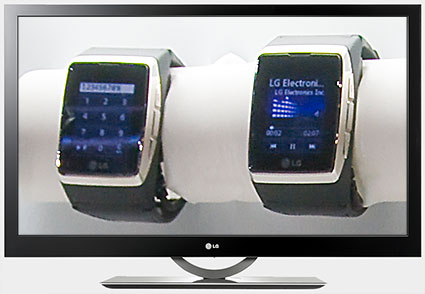 A poster child for almost all the new HDTV trends at CES 2009, LG's LHX 55" LCD TV is less than one-inch thick at its thinnest point but still features a 240Hz display with LED backlighting with Local Dimming. It also includes Full HD 1080p via Uncompressed Wireless Transmission from a media box. The image is the LG wrist telephone. "Calling Dick Tracy." Widgets
Widgets - those little iconic Internet thingamabobs - are coming soon to a TV near you. At this CES, TVs are rolling out the red carpet for Web content and widgets are becoming the portals to the Internet. Basically, you will connect these web enabled TVs to your home network. Some of HDTVs will have wireless capabilities, others will provide an Ethernet port. When you turn on the web feature, widgets will pop up on your screen that you can access by clicking the TV's remote. For example, Yahoo Widgets were finding a home on a number of TVs. If you have the Weather widget, you can set it to display your city's current temperature and see a five day forecast. Which Web content providers are available on the TV often depends on the manufacturer and their partnership agreements. Though I saw some systems that are provider agnostic, which means that you can add any widgets that you can find on the Internet. 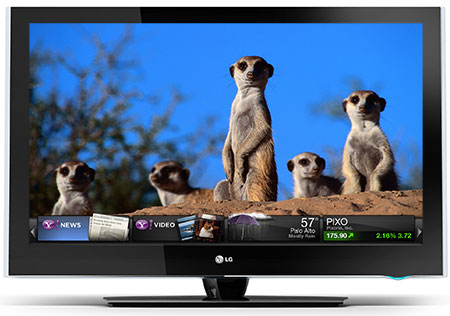 Yahoo Widgets I am curious to see how this movement of morphing the family TV from traditional broadcast to 21st Century broadband plays out. I'll admit to being a fuddy-duddy when it comes to watching TV. I just want to sit back and enjoy House or True Blood without some annoying doohickey diverting my attention. Though viewing CNBC in HD has acclimated me to consuming multiple content streams. Wireless
Nowadays this term has two applications when it comes to HDTVs. The newest one relates to the connection to the Internet. In this case, a wireless TV would be like a wireless laptop computer. I don't know of any 2008 TVs that have integrated wireless network hardware. A few models will be appearing this year. Others will be supplying a small wireless dongle that attaches to the TV's Ethernet port. I think this wireless solution will definitely facilitate acceptance of widgets. It will be much easier for most of us to install a wireless router than it would be to snake Cat 5 cables to our HDTVs. The other wireless situation involves all the audio/video cables that connect the TV to the various components like set top boxes and DVD players. Manufacturers have been wrestling with this problem for years. The roadblock was to develop a reliable system that could transmit the massive amount of data inherent in a high definition video stream. Engineers have hatched a number of remedies, most of them requiring some form of video compression. From what I have seen in the booths, the technology is ready for prime time. Though I'll hold off on granting a stamp of approval until I review a system. I am eagerly awaiting the day when I can eliminate the Hydra head of cables entwining my TV. 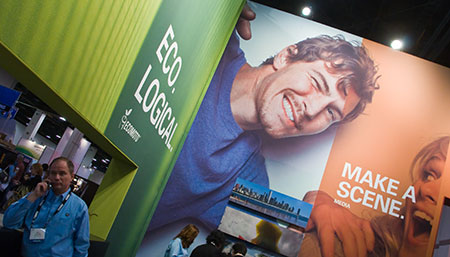 How Green is My TV?
Green and Eco were echoing around the massive exhibit halls. 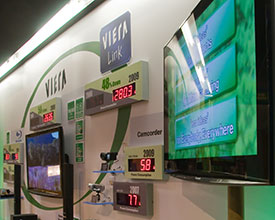 Almost every HDTV display had these little red meters showing that the power consumption of their eco-friendly 2009 models were up to 50% less than their 2008 TVs. I applaud the manufacturers. They understand the broader concept that Green is a cradle to grave proposition and they are paying attention to the production and packaging process as well as recycling. We'll write more about Energy Star ratings for HDTVs soon. It's the Stupid Economy
There is no avoiding the subject. Though you had the feeling that amidst the glitz of Vegas, exhibitors and press alike were whistling through the graveyard. Everyone seemed to be tightening their belts and girding for the first half of the year. I'm not privy to balance sheets, but I can imagine that R&D budgets are shrinking and we'll see fewer new models being released. That sword cuts both ways and I think prices for HDTVs will remain depressed. If you have the discretionary cash, it's definitely a buyer's market. 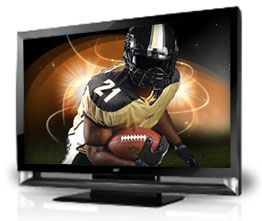 VIZIO's 550XVT For example, you always had to pay a premium for LCDs over 47", but 55" models are arriving this quarter without the extra markup. VIZIO has already released the VF550XVT, a 55" version of their top of the line XVT series, for $1999. And don't assume that companies aren't planning ahead. Perhaps the most evocative bridge to the future was the Cell box that Toshiba had attached to a TV with four times the native resolution of a 1080p HDTV, (3940 x 2160 pixels). Vendors have been showing off these 4K by 2K TVs for a couple of years. The problem is that almost all content is no greater than 1920 x 1080 and it doesn't look good when stretched out on this TV. The Cell is a multi-core video processing powerhouse that can expand a 1080p signal to fit this 8K TV and still maintain image quality. The Toshiba rep would not commit to a release date or a price for either the Cell or the TV. 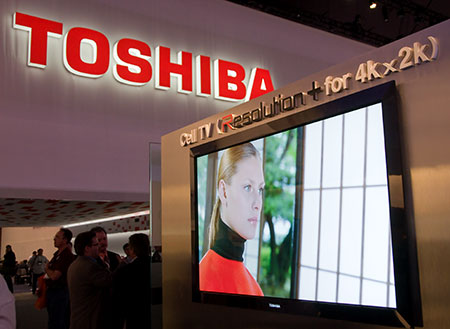 And the beat goes on. Stay tuned. |
Bookmark:
![]() del.icio.us
del.icio.us
![]() Reddit
Reddit
![]() Google
Google
| Send this Page | Print this Page | Report Errors |

